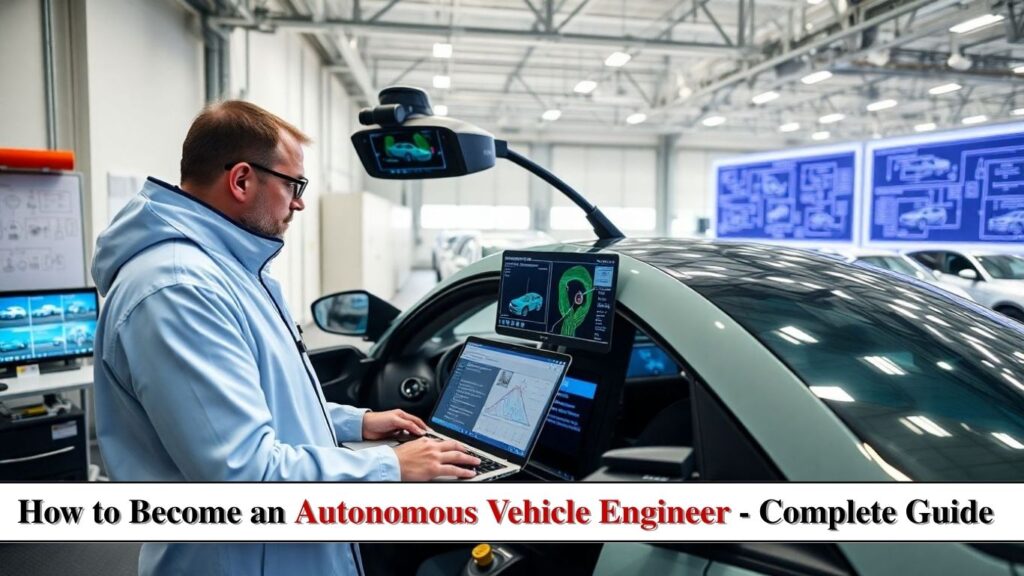
Introduction
Autonomous vehicles (AVs) are revolutionizing the transportation industry, promising safer, more efficient, and eco-friendly mobility. Behind this groundbreaking technology are Autonomous Vehicle Engineers, the brains responsible for designing, developing, and deploying self-driving cars.
If you’re fascinated by AI, robotics, and cutting-edge automotive technology, a career as an Autonomous Vehicle Engineer could be your dream job. In this comprehensive guide, we’ll explore:
- History of Autonomous Vehicles
- Roles & Responsibilities of an AV Engineer
- Salary Expectations
- Required Qualifications & Skills
- How to Get Started
- Future Scope & Industry Trends
Let’s dive in!
History of Autonomous Vehicles
The concept of self-driving cars isn’t new—it dates back to the 1920s with radio-controlled vehicles. However, significant advancements began in the 1980s with projects like Carnegie Mellon University’s Navlab and ALV (Autonomous Land Vehicle).
Key Milestones:
- 1986: Ernst Dickmanns (Germany) developed a vision-guided autonomous Mercedes van.
- 2004: DARPA Grand Challenge spurred innovation in AVs.
- 2009: Google (now Waymo) launched its self-driving car project.
- 2015: Tesla introduced Autopilot, bringing semi-autonomous driving to consumers.
- 2020s: Companies like Waymo, Cruise, and Aurora are testing fully autonomous taxis.
Today, AVs rely on AI, machine learning, LiDAR, and advanced sensors to navigate roads safely.
Roles & Responsibilities of an Autonomous Vehicle Engineer
An Autonomous Vehicle Engineer works on various aspects of self-driving technology, including software, hardware, and system integration.
Key Responsibilities:
- Software Development:
- Design perception algorithms (object detection, lane tracking).
- Develop path planning & control systems.
- Implement machine learning models for decision-making.
- Sensor Integration:
- Work with LiDAR, radar, cameras, and ultrasonic sensors.
- Ensure accurate data fusion for real-time navigation.
- Testing & Validation:
- Conduct simulation testing (using tools like CARLA, Gazebo).
- Perform real-world road tests and analyze performance.
- Safety & Compliance:
- Ensure AV systems meet ISO 26262 (Functional Safety) standards.
- Address cybersecurity risks in autonomous systems.
- Collaboration:
- Work with robotics engineers, data scientists, and automotive experts.
Autonomous Vehicle Engineer Salary
Salaries vary based on experience, location, and employer.
Average Salaries (2024):
| Country | Entry-Level | Mid-Level | Senior-Level |
|---|---|---|---|
| USA | $90,000 | $120,000 | $150,000+ |
| UK | £50,000 | £70,000 | £90,000+ |
| Germany | €60,000 | €80,000 | €100,000+ |
| India | ₹8LPA | ₹15LPA | ₹25LPA+ |
Top Paying Companies:
- Waymo, Tesla, Cruise, NVIDIA, Aurora, Zoox
Qualifications & Skills Required
To become an Autonomous Vehicle Engineer, you need a mix of education, technical skills, and hands-on experience.
Educational Background:
- Bachelor’s Degree in:
- Computer Science
- Electrical/Electronics Engineering
- Mechanical Engineering (with robotics focus)
- Artificial Intelligence & Machine Learning
- Master’s/PhD (Preferred for research roles)
Technical Skills:
✔ Programming: Python, C++, ROS (Robot Operating System)
✔ Machine Learning: TensorFlow, PyTorch, Computer Vision (OpenCV)
✔ Robotics: SLAM (Simultaneous Localization & Mapping), Control Systems
✔ Sensor Tech: LiDAR, Radar, Camera Calibration
✔ Simulation Tools: CARLA, Gazebo, MATLAB/Simulink
Soft Skills:
✔ Problem-Solving
✔ Team Collaboration
✔ Analytical Thinking
How to Get Started as an Autonomous Vehicle Engineer
Step 1: Build a Strong Foundation
- Learn Python & C++ (essential for AV programming).
- Study Linear Algebra, Calculus, and Probability (crucial for robotics).
Step 2: Gain Relevant Knowledge
- Take online courses:
- Coursera: Self-Driving Cars Specialization (University of Toronto)
- Udacity: Autonomous Systems Engineer Nanodegree
- edX: Robotics MicroMasters (MIT)
Step 3: Work on Projects
- Build a mini autonomous robot (Raspberry Pi + OpenCV).
- Participate in autonomous vehicle competitions (e.g., Formula Student Driverless).
Step 4: Internships & Industry Exposure
- Apply for internships at Tesla, Waymo, or automotive OEMs.
- Contribute to open-source AV projects (Apollo by Baidu, Autoware).
Step 5: Get Certified
- NVIDIA’s Autonomous Vehicle Certification
- SAE International’s AV Standards Courses
Future Scope of Autonomous Vehicle Engineers
The AV industry is booming, with a projected market size of $2 trillion by 2030 (McKinsey).
Emerging Trends:
🚗 Level 5 Autonomy: Fully driverless cars by 2030+
🚀 AI Advancements: GPT-4 & multimodal AI improving decision-making
🌍 Smart Cities: AV integration with IoT & 5G networks
🔋 Electric & Autonomous Fusion: Companies like Tesla leading the shift
Job Growth:
- 30%+ growth in AV engineering roles by 2030 (BLS).
- High demand in USA, Germany, China, and India.
Conclusion
Becoming an Autonomous Vehicle Engineer is a challenging yet rewarding career path. With the right skills, education, and hands-on experience, you can be at the forefront of the self-driving revolution.
Key Takeaways:
✅ Master AI, robotics, and sensor tech
✅ Gain real-world experience through projects & internships
✅ Stay updated with industry trends & certifications
The future of transportation is autonomous, and skilled engineers will lead the way. Are you ready to drive innovation? 🚗💨
By following this guide, you’ll be well-equipped to launch your career in autonomous vehicle engineering and contribute to the next generation of smart transportation! 🚀













Post Comment